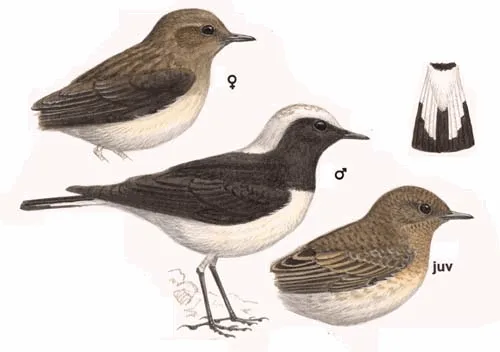
Pied Wheatear
Pied Wheatear (Oenanthe pleschanka)
[order] PASSERIFORMES | [family] Muscicapidae | [latin] Oenanthe pleschanka | [UK] Pied Wheatear | [FR] Traquet pie | [DE] Nonnen-Steinschmatzer | [ES] Collalba pia | [NL] Bonte Tapuit
Subspecies
Monotypic species
Physical charateristics
Pied Wheaear of distinctly lighter build than Northern Wheeatear with slightly shorter bill and wings and 15% shorter legs, but with tail longer and proportionately appearing more so.
In spring, crown and wide nape white, with faint silver or buff tone most obvious from behind and becoming grey with wear. Face, chin, throat, upper breast, sides of neck, shoulder area, back, and wings black.
Lower breast, underbody, rump, and upper tail-coverts white, variably tinged buff. Axillaries and under wing-coverts black, contrasting with dusky undersurface to flight-feathers.
Tail with black central feathers and black tips to outer ones, tips noticeably longer and extending further up tail towards outermost. Sexes markedly dissimilar in breeding plumage.
In spring, crown and wide nape white, with faint silver or buff tone most obvious from behind and becoming grey with wear. Face, chin, throat, upper breast, sides of neck, shoulder area, back, and wings black.
Lower breast, underbody, rump, and upper tail-coverts white, variably tinged buff. Axillaries and under wing-coverts black, contrasting with dusky undersurface to flight-feathers.
Tail with black central feathers and black tips to outer ones, tips noticeably longer and extending further up tail towards outermost. Sexes markedly dissimilar in breeding plumage.
Listen to the sound of Pied Wheatear
[audio:http://www.aviflevoland.nl/sounddb/P/Pied Wheatear.mp3]
Copyright remark: Most sounds derived from xeno-canto
| wingspan min.: | 25 | cm | wingspan max.: | 27 | cm |
| size min.: | 14 | cm | size max.: | 15 | cm |
| incubation min.: | 13 | days | incubation max.: | 14 | days |
| fledging min.: | 13 | days | fledging max.: | 14 | days |
| broods: | 1 | eggs min.: | 4 | ||
| eggs max.: | 6 |
Range
Eurasia : Southcentral
Habitat
Approximately replaces Black-eared Wheatear in continental mid latitudes of eastern sector of west Palearctic, through warmer temperate and steppe zones, largely in lowland but ranging up to 1800 m.
Typically occupies desolate stony stretches with scattered boulders and more seldom fallow fields at margin of small cultivated areas.
Typically occupies desolate stony stretches with scattered boulders and more seldom fallow fields at margin of small cultivated areas.
Reproduction
Early May in Ukraine, May-June in extralimital former USSR. Nest site is a in hole in rock or bank, under stone, or sometimes in building. Nest is a cup of dry grass and stems, lined with finer grasses, roots, and wool or hair.
4-6 eggs, incubation 13-14 days tended by female only.
4-6 eggs, incubation 13-14 days tended by female only.
Feeding habits
Almost entirely insects. Taken mostly from bare ground but occasionally from low vegetation.
Typically watches for prey from perch up to 1.5 m high and flies down to make capture, returning to same perch immediately, rarely spending time on ground.
Typically watches for prey from perch up to 1.5 m high and flies down to make capture, returning to same perch immediately, rarely spending time on ground.
Conservation
This species has an extremely large range, and hence does not approach the thresholds for Vulnerable under the range size criterion (Extent of Occurrence <20,000 km2 combined with a declining or fluctuating range size, habitat extent/quality, or population size and a small number of locations or severe fragmentation). The population trend appears to be stable, and hence the species does not approach the thresholds for Vulnerable under the population trend criterion (>30% decline over ten years or three generations). The population size is very large, and hence does not approach the thresholds for Vulnerable under the population size criterion (<10,000 mature individuals with a continuing decline estimated to be >10% in ten years or three generations, or with a specified population structure). For these reasons the species is evaluated as Least Concern.

Migration
Migratory; winters in eastern Africa (Sudan to Somalia south to north-east Tanzania) and south-west Arabia (Yemen). Moves to south and south-west on broad front via Turkey, Middle East, and Pakistan; leaves breeding grounds August-October, returning mid-March to early May (from early April in Rumania); recorded in Eritrea from early September to early May, in Kenya mid-October to early April.
Distribution map

]]>
